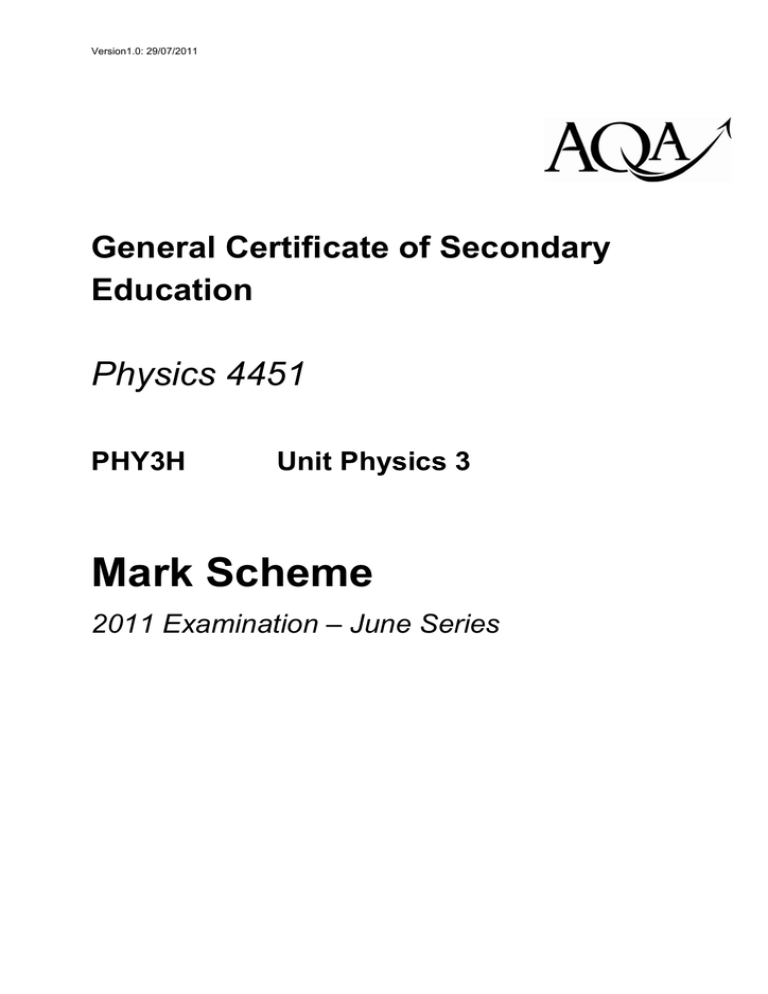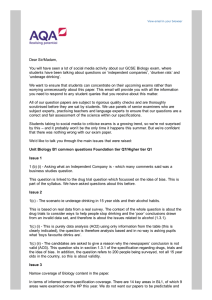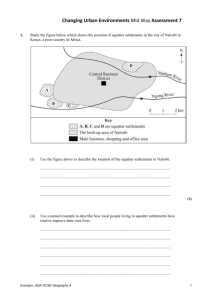
Version1.0: 29/07/2011
General Certificate of Secondary
Education
Physics 4451
PHY3H
Unit Physics 3
Mark Scheme
2011 Examination – June Series
Mark schemes are prepared by the Principal Examiner and considered, together with the
relevant questions, by a panel of subject teachers. This mark scheme includes any
amendments made at the standardisation meeting attended by all examiners and is the scheme
which was used by them in this examination. The standardisation meeting ensures that the
mark scheme covers the candidates’ responses to questions and that every examiner
understands and applies it in the same correct way. As preparation for the standardisation
meeting each examiner analyses a number of candidates’ scripts: alternative answers not
already covered by the mark scheme are discussed at the meeting and legislated for. If, after
this meeting, examiners encounter unusual answers which have not been discussed at the
meeting they are required to refer these to the Principal Examiner.
It must be stressed that a mark scheme is a working document, in many cases further
developed and expanded on the basis of candidates’ reactions to a particular paper.
Assumptions about future mark schemes on the basis of one year’s document should be
avoided; whilst the guiding principles of assessment remain constant, details will change,
depending on the content of a particular examination paper.
Further copies of this Mark Scheme are available to download from the AQA Website: www.aqa.org.uk
Copyright © 2011 AQA and its licensors. All rights reserved.
COPYRIGHT
AQA retains the copyright on all its publications. However, registered centres for AQA are permitted to copy material
from this booklet for their own internal use, with the following important exception: AQA cannot give permission to
centres to photocopy any material that is acknowledged to a third party even for internal use within the centre.
Set and published by the Assessment and Qualifications Alliance.
The Assessment and Qualifications Alliance (AQA) is a company limited by guarantee registered in England and Wales (company number 3644723) and a registered charity (registered charity number 1073334).
Registered address: AQA, Devas Street, Manchester M15 6EX
2
Physics – PHY3H – AQA GCSE Mark Scheme 2011 June Series
Marking Guidance for Examiners
GCSE Science Papers
1.
General
The mark scheme for each question shows:
•
the marks available for each part of the question
•
the total marks available for the question
•
the typical answer or answers which are expected
•
extra information to help the Examiner make his or her judgement and help to
delineate what is acceptable or not worthy of credit or, in discursive answers,
to give an overview of the area in which a mark or marks may be awarded.
The extra information is aligned to the appropriate answer in the left-hand part of
the mark scheme and should only be applied to that item in the mark scheme.
At the beginning of a part of a question a reminder may be given, for example:
where consequential marking needs to be considered in a calculation;
or the answer may be on the diagram or at a different place on the script.
In general the right hand side of the mark scheme is there to provide those extra
details which confuse the main part of the mark scheme yet may be helpful in
ensuring that marking is straightforward and consistent.
2.
3.
Emboldening
2.1
In a list of acceptable answers where more than one mark is available ‘any
two from’ is used, with the number of marks emboldened. Each of the
following lines is a potential mark.
2.2
A bold and is used to indicate that both parts of the answer are required to
award the mark.
2.3
Alternative answers acceptable for a mark are indicated by the use of or.
(Different terms in the mark scheme are shown by a / ; eg allow smooth /
free movement.)
Marking points
3.1
Marking of lists
This applies to questions requiring a set number of responses, but for
which candidates have provided extra responses. The general principle to
be followed in such a situation is that ‘right + wrong = wrong’.
Each error/contradiction negates each correct response. So, if the number
of error/contradictions equals or exceeds the number of marks available for
the question, no marks can be awarded.
However, responses considered to be neutral (indicated as * in example 1)
are not penalised.
3
Physics – PHY3H – AQA GCSE Mark Scheme 2011 June Series
Example 1: What is the pH of an acidic solution? (1 mark)
Candidate
Response
Marks
awarded
1
4,8
0
2
green, 5
0
3
red*, 5
1
4
red*, 8
0
Example 2: Name two planets in the solar system. (2 marks)
3.2
Candidate
Response
Marks awarded
1
Pluto, Mars, Moon
1
2
Pluto, Sun, Mars,
Moon
0
Use of chemical symbols / formulae
If a candidate writes a chemical symbol / formula instead of a required
chemical name, full credit can be given if the symbol / formula is correct
and if, in the context of the question, such action is appropriate.
3.3
Marking procedure for calculations
Full marks can be given for a correct numerical answer, as shown in the
column ‘answers’, without any working shown.
However if the answer is incorrect, mark(s) can be gained by correct
substitution / working and this is shown in the ‘extra information’ column;
3.4
Interpretation of ‘it’
Answers using the word ‘it’ should be given credit only if it is clear that the
‘it’ refers to the correct subject.
3.5
Errors carried forward
Any error in the answers to a structured question should be penalised once
only.
Papers should be constructed in such a way that the number of times
errors can be carried forward are kept to a minimum. Allowances for errors
carried forward are most likely to be restricted to calculation questions and
should be shown by the abbreviation e.c.f. in the marking scheme.
3.6
Phonetic spelling
The phonetic spelling of correct scientific terminology should be credited
unless there is a possible confusion with another technical term.
3.7
Brackets
(…..) are used to indicate information which is not essential for the mark to
be awarded but is included to help the examiner identify the sense of the
answer required.
4
Physics – PHY3H – AQA GCSE Mark Scheme 2011 June Series
PHY3H
Question 1
question
1(a)
answers
extra information
microphone
mark
1
1(b)(i)
vertical line from any maxima or
minima to axis
do not penalise minor errors but
do not allow unless intention is
clear
1
1(b)(ii)
loudness / volume / intensity /
energy
do not accept noise
1
1(c)
17
this answer only
1
1(d)
the greater the distance, the
smaller the amplitude
accept volume / intensity / energy
/ loudness for amplitude
1
or
there is a (strong)
negative correlation between
distance and amplitude
or
there is an inverse square
relationship between distance and
amplitude
do not accept distance and
amplitude are inversely
proportional
1(e)
20 Hz
either order
1
20,000 Hz
accept 20 kHz provided unit has
been clearly changed
1
Total
7
5
Physics – PHY3H – AQA GCSE Mark Scheme 2011 June Series
PHY3H
Question 2
question
2(a)(i)
answers
extra information
turning effect
accept turning force
mark
1
accept force x distance
(accept symbols only if correctly
defined)
do not accept newtons x metres
2(a)(ii)
stop apparatus falling over
accept holds the stand in place
1
accept make it safer / stable
references to balanced /
equilibrium are insufficient
2(a)(iii)
as x increases y increases
1
in same proportion / ratios
1
allow both marks for they are
directly proportional
or
a specific example eg doubling y,
doubles x
allow both marks for a correct
answer giving figures
eg they increase in the ratio of
1 to 7
allow for 1 mark positive
correlation
2(a)(iv)
2(b)
the centre of mass of the ruler is at
the axis of rotation
1
108
allow 1 mark for correct
substitution ie 240 x 0.45
2
newton metres / Nm
symbols must be correct
1
for full credit the unit must be
consistent with the numerical
answer
Total
8
6
Physics – PHY3H – AQA GCSE Mark Scheme 2011 June Series
PHY3H
Question 3
question
answers
extra information
mark
3(a)
(Jupiter’s) gravitational pull
accept (Jupiter’s) gravity
1
3(b)
extrapolation which takes account
of the line of best fit passing
through the origin (+ / - 1 square)
accept a straight line or curve
1
do not accept a line dot to dot
1
a correct reading taken from the
candidate’s line ( + / - ½ square)
if no line drawn allow for 1 mark
a value between 8 – 12 inclusive
3(c)
as the distance increases the
time increases
or
as the distance decreases the
time decreases
or
there is a positive correlation
1
3(d)
any one from:
1
•
computers able to process data
accept better / advanced
technology
•
telescopes in space / on
satellites / above the Earth /
atmosphere
reference to satellites alone
insufficient
•
instruments other than optical
telescopes (available)
accept any valid reason
do not accept just better
telescopes
Total
5
7
Physics – PHY3H – AQA GCSE Mark Scheme 2011 June Series
PHY3H
Question 4
question
4(a)
answers
extra information
convex
do not accept convex lens
mark
1
do not accept diverging
4(b)
two rays correctly drawn from the
top of the object to the mirror with
correct reflection
allow 1 mark for each
2
1
image where virtual rays
intersect behind the mirror then
vertically downwards to the axis
only required once but any
contrary or ambiguous direction
cancels this mark
correct ray direction shown by
arrow head
1
last two marking points only score
if rays are shown to be reflected
example of a 4 mark response
the other acceptable rays are:
from the top of the object directed
towards C reflected back along its
own path
from the top of the object directed
towards F reflected at the mirror
parallel to the principal axis
Question 4 continues on the next page
8
Physics – PHY3H – AQA GCSE Mark Scheme 2011 June Series
PHY3H
Question 4 continued
question
4(c)
answers
extra information
mark
diminished
accept smaller
1
virtual
accept cannot be formed on a
screen
1
ignore imaginary
either order but do not credit
either response if directly
contradicted
eg diminished and enlarged
virtual and real
Total
7
9
Physics – PHY3H – AQA GCSE Mark Scheme 2011 June Series
PHY3H
Question 5
question
5(a)
answers
extra information
refraction
mark
1
5(b)(i)
converging
accept convex
1
5(b)(ii)
cause the light (rays) to meet on /
focus at retina / back of eye
do not accept hit the retina only
1
5(c)
silicone is removed from the
lens(es)
1
1
lens(es) thinner in / at the
middle (than at the edge)
or
lens(es) became concave /
diverging
1
diverges(s) the light which (now)
meets / focuses at the retina /
back of the eye
Total
6
10
Physics – PHY3H – AQA GCSE Mark Scheme 2011 June Series
PHY3H
Question 6
question
6(a)
answers
extra information
mark
(forces due to) gravity and
radiation pressure
1
correct direction of forces
1
(forces) are balanced /
equilibrium / equal
1
accept for 3 marks an answer in
terms of
sufficient hydrogen
(1)
to keep fusion reaction
(1)
reference to burn / burning
negates this mark
going at a continuous /steady rate
(1)
if fuel is used instead of hydrogen
maximum of 2 marks
6(b)
the Sun will remain stable
(for several billion years)
1
accept a specific example of
evidence
eg that the Sun has
remained stable during the life
of our planet / for 4.5 billion years
or
still contains more than 50 %
hydrogen
or
by comparison with the lifecycle of
(similar) stars
based on evidence
1
allow a refutation
eg not based on prejudice / whim
/ hearsay / folk law / historical or
religious authority
Total
5
11
Physics – PHY3H – AQA GCSE Mark Scheme 2011 June Series
PHY3H
Question 7
question
7(a)
answers
extra information
400 000
allow 1 mark for correct
substitution ie
25000 = 800
?
12800
mark
2
or
25 = 800
? 12800
1
volt(s) / V
an answer 400 gains 2 marks
an answer 400 kilovolts / kV gains
3 marks
although the unit mark is
independent to gain 3 marks it
must be consistent with the
numerical value
7(b)
do not accept any response in
terms of heat insulation, safety or
electric shock
any one from:
• (so that there is) no short
circuit
• (so that the) current goes
round the coil
•
1
do not accept electricity for
current
(so that the) current does not
enter the core
Question 7 continues on the next page
12
Physics – PHY3H – AQA GCSE Mark Scheme 2011 June Series
PHY3H
Question 7 continues
question
answers
extra information
7(c)
(the alternating p.d. in the primary
causes) an (alternating) current in
the primary
reference to the current in the
core negates this mark
(causes an) alternating / changing
(magnetic) field in the (iron) core
1
1
accept in / through or similar for
across
accept current for p.d.
accept output (coil) for secondary
(coil)
induces (alternating) p.d. across
the secondary (coil)
mark
1
to gain 3 marks the sequence
must be correct
Total
7
13






